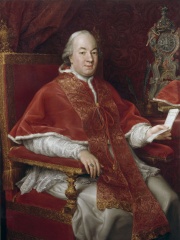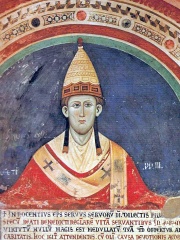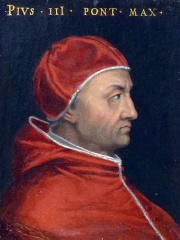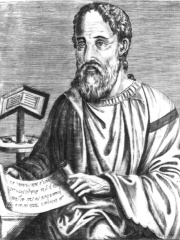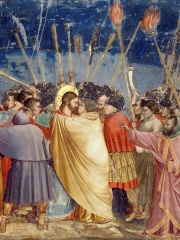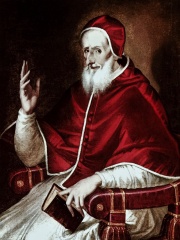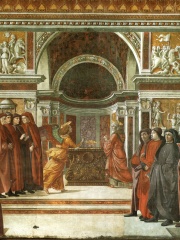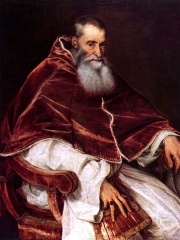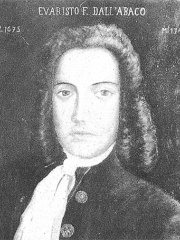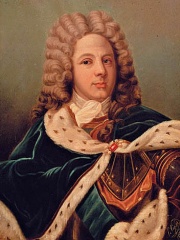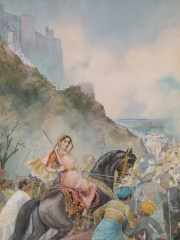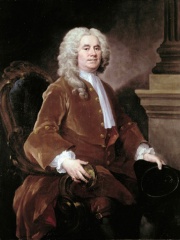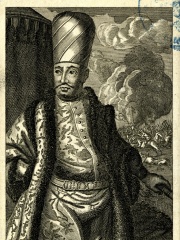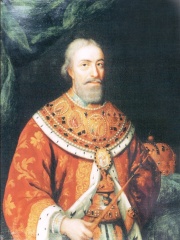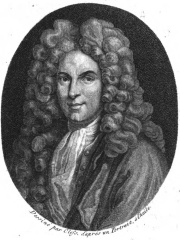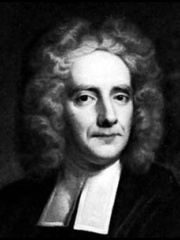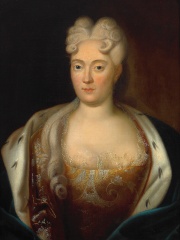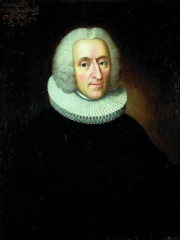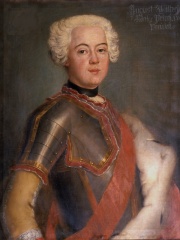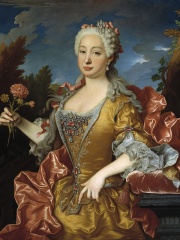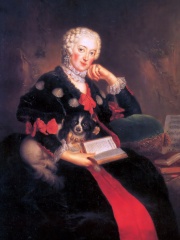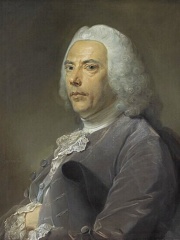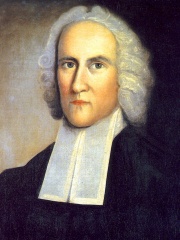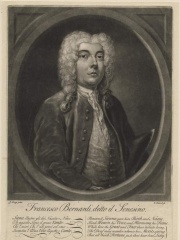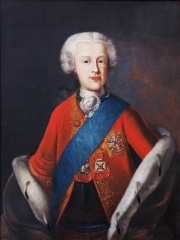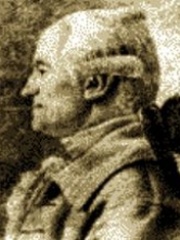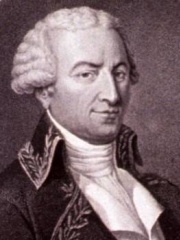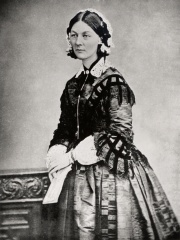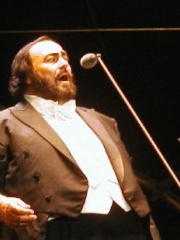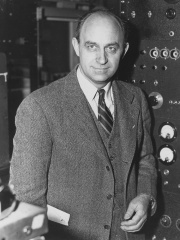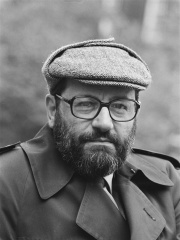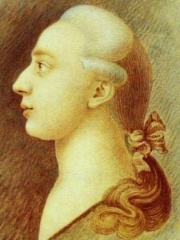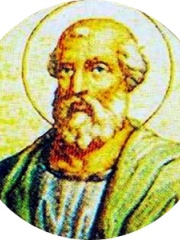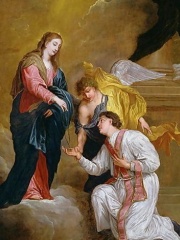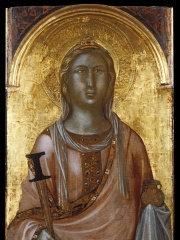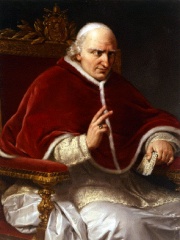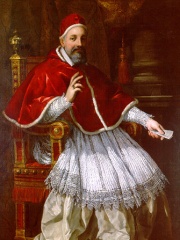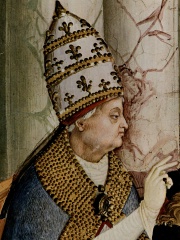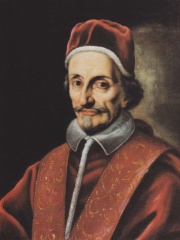RELIGIOUS FIGURE
Pope Benedict XIV
1675 - 1758
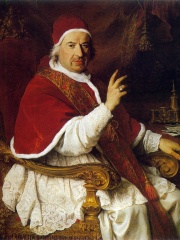
 Pope Benedict XIV
Pope Benedict XIV
Pope Benedict XIV (Latin: Benedictus XIV; Italian: Benedetto XIV; 31 March 1675 – 3 May 1758), born Prospero Lorenzo Lambertini, was head of the Catholic Church and ruler of the Papal States from 17 August 1740 to his death in May 1758. Perhaps one of the best scholars to sit on the papal throne, yet often overlooked, he promoted scientific learning, the Baroque arts, reinvigoration of Thomism, and the study of the human form. Firmly committed to carrying out the decrees of the Council of Trent and Catholic teaching, Benedict removed changes previously made to the Breviary, sought peacefully to reverse growing secularism in European courts, invigorated ceremonies with great pomp, and throughout his life and his reign published numerous theological and ecclesiastical treatises. In governing the Papal States, he reduced taxation on some products, but also raised taxes on others; he also encouraged agriculture and supported free trade within the Papal States. Read more on Wikipedia
His biography is available in 80 different languages on Wikipedia. Pope Benedict XIV is the 80th most popular religious figure (up from 188th in 2024), the 93rd most popular biography from Italy (up from 215th in 2019) and the 27th most popular Italian Religious Figure.
Pope Benedict XIV was most famous for his efforts to reform the Catholic Church in the 18th century.
Memorability Metrics
Page views of Pope Benedict XIV by language
Among RELIGIOUS FIGURES
Among religious figures, Pope Benedict XIV ranks 80 out of 3,187. Before him are Pope Pius VI, Abu Hanifa, Isaiah, Pope Innocent III, Pope Pius III, and Eusebius. After him are 14th Dalai Lama, Judas Iscariot, Pope Pius V, Ruhollah Khomeini, Zechariah, and Pope Paul III.
Most Popular Religious Figures in Wikipedia
Go to all RankingsPope Pius VI
1717 - 1799
HPI: 83.62
Rank: 74
Abu Hanifa
698 - 767
HPI: 83.39
Rank: 75
Isaiah
800 BC - 700 BC
HPI: 83.38
Rank: 76
Pope Innocent III
1160 - 1216
HPI: 83.33
Rank: 77
Pope Pius III
1439 - 1503
HPI: 83.27
Rank: 78
Eusebius
265 - 339
HPI: 83.24
Rank: 79
Pope Benedict XIV
1675 - 1758
HPI: 83.17
Rank: 80
14th Dalai Lama
1935 - Present
HPI: 83.17
Rank: 81
Judas Iscariot
50 - 30
HPI: 83.13
Rank: 82
Pope Pius V
1504 - 1572
HPI: 83.13
Rank: 83
Ruhollah Khomeini
1902 - 1989
HPI: 83.10
Rank: 84
Zechariah
90 BC - 100
HPI: 83.06
Rank: 85
Pope Paul III
1468 - 1549
HPI: 83.04
Rank: 86
Contemporaries
Among people born in 1675, Pope Benedict XIV ranks 1. After him are Emperor Higashiyama, Evaristo Felice Dall'Abaco, Louis de Rouvroy, duc de Saint-Simon, Tarabai, William Jones, Claude Alexandre de Bonneval, Vakhtang VI of Kartli, Guillaume Delisle, Frederick William, Duke of Mecklenburg-Schwerin, Samuel Clarke, and Princess Sibylle of Saxe-Lauenburg. Among people deceased in 1758, Pope Benedict XIV ranks 1. After him are Hans Egede, Prince Augustus William of Prussia, Barbara of Portugal, Wilhelmine of Prussia, Margravine of Brandenburg-Bayreuth, Pierre Bouguer, Jonathan Edwards, Senesino, Johan Helmich Roman, Ernest Augustus II, Duke of Saxe-Weimar-Eisenach, Johann Friedrich Fasch, and Antoine de Jussieu.
Others Born in 1675
Go to all RankingsPope Benedict XIV
RELIGIOUS FIGURE
1675 - 1758
HPI: 83.17
Rank: 1
Emperor Higashiyama
POLITICIAN
1675 - 1710
HPI: 70.42
Rank: 2
Evaristo Felice Dall'Abaco
COMPOSER
1675 - 1742
HPI: 65.49
Rank: 3
Louis de Rouvroy, duc de Saint-Simon
WRITER
1675 - 1755
HPI: 65.36
Rank: 4
Tarabai
POLITICIAN
1675 - 1761
HPI: 62.94
Rank: 5
William Jones
MATHEMATICIAN
1675 - 1749
HPI: 61.31
Rank: 6
Claude Alexandre de Bonneval
MILITARY PERSONNEL
1675 - 1747
HPI: 61.30
Rank: 7
Vakhtang VI of Kartli
POLITICIAN
1675 - 1737
HPI: 60.70
Rank: 8
Guillaume Delisle
GEOGRAPHER
1675 - 1726
HPI: 59.61
Rank: 9
Frederick William, Duke of Mecklenburg-Schwerin
POLITICIAN
1675 - 1713
HPI: 59.40
Rank: 10
Samuel Clarke
PHILOSOPHER
1675 - 1729
HPI: 58.53
Rank: 11
Princess Sibylle of Saxe-Lauenburg
POLITICIAN
1675 - 1733
HPI: 57.71
Rank: 12
Others Deceased in 1758
Go to all RankingsPope Benedict XIV
RELIGIOUS FIGURE
1675 - 1758
HPI: 83.17
Rank: 1
Hans Egede
RELIGIOUS FIGURE
1686 - 1758
HPI: 70.91
Rank: 2
Prince Augustus William of Prussia
POLITICIAN
1722 - 1758
HPI: 68.31
Rank: 3
Barbara of Portugal
POLITICIAN
1711 - 1758
HPI: 67.81
Rank: 4
Wilhelmine of Prussia, Margravine of Brandenburg-Bayreuth
COMPOSER
1709 - 1758
HPI: 67.44
Rank: 5
Pierre Bouguer
MATHEMATICIAN
1698 - 1758
HPI: 67.02
Rank: 6
Jonathan Edwards
PHILOSOPHER
1703 - 1758
HPI: 64.71
Rank: 7
Senesino
SINGER
1686 - 1758
HPI: 63.29
Rank: 8
Johan Helmich Roman
COMPOSER
1694 - 1758
HPI: 62.11
Rank: 9
Ernest Augustus II, Duke of Saxe-Weimar-Eisenach
POLITICIAN
1737 - 1758
HPI: 61.70
Rank: 10
Johann Friedrich Fasch
MUSICIAN
1688 - 1758
HPI: 61.65
Rank: 11
Antoine de Jussieu
BIOLOGIST
1686 - 1758
HPI: 60.87
Rank: 12
In Italy
Among people born in Italy, Pope Benedict XIV ranks 93 out of 5,161. Before him are Pope Innocent III (1160), Pope Pius III (1439), Sophia Loren (1934), Florence Nightingale (1820), Luciano Pavarotti (1935), and Enrico Fermi (1901). After him are Umberto Eco (1932), Pope Pius V (1504), Giacomo Casanova (1725), Pope Paul III (1468), Pope Linus (1), and Saint Valentine (226).
Others born in Italy
Go to all RankingsPope Innocent III
RELIGIOUS FIGURE
1160 - 1216
HPI: 83.33
Rank: 87
Pope Pius III
RELIGIOUS FIGURE
1439 - 1503
HPI: 83.27
Rank: 88
Sophia Loren
ACTOR
1934 - Present
HPI: 83.26
Rank: 89
Florence Nightingale
PHYSICIAN
1820 - 1910
HPI: 83.23
Rank: 90
Luciano Pavarotti
SINGER
1935 - 2007
HPI: 83.23
Rank: 91
Enrico Fermi
PHYSICIST
1901 - 1954
HPI: 83.22
Rank: 92
Pope Benedict XIV
RELIGIOUS FIGURE
1675 - 1758
HPI: 83.17
Rank: 93
Umberto Eco
WRITER
1932 - 2016
HPI: 83.13
Rank: 94
Pope Pius V
RELIGIOUS FIGURE
1504 - 1572
HPI: 83.13
Rank: 95
Giacomo Casanova
WRITER
1725 - 1798
HPI: 83.07
Rank: 96
Pope Paul III
RELIGIOUS FIGURE
1468 - 1549
HPI: 83.04
Rank: 97
Pope Linus
RELIGIOUS FIGURE
1 - 79
HPI: 83.03
Rank: 98
Saint Valentine
RELIGIOUS FIGURE
226 - 273
HPI: 83.01
Rank: 99
Among RELIGIOUS FIGURES In Italy
Among religious figures born in Italy, Pope Benedict XIV ranks 27. Before him are Saint Lucy (283), Pope Pius VIII (1761), Pope Urban VIII (1568), Pope Pius VI (1717), Pope Innocent III (1160), and Pope Pius III (1439). After him are Pope Pius V (1504), Pope Paul III (1468), Pope Linus (1), Saint Valentine (226), Pope Pius II (1405), and Pope Innocent XI (1611).
Saint Lucy
283 - 304
HPI: 83.96
Rank: 21
Pope Pius VIII
1761 - 1830
HPI: 83.92
Rank: 22
Pope Urban VIII
1568 - 1644
HPI: 83.69
Rank: 23
Pope Pius VI
1717 - 1799
HPI: 83.62
Rank: 24
Pope Innocent III
1160 - 1216
HPI: 83.33
Rank: 25
Pope Pius III
1439 - 1503
HPI: 83.27
Rank: 26
Pope Benedict XIV
1675 - 1758
HPI: 83.17
Rank: 27
Pope Pius V
1504 - 1572
HPI: 83.13
Rank: 28
Pope Paul III
1468 - 1549
HPI: 83.04
Rank: 29
Pope Linus
1 - 79
HPI: 83.03
Rank: 30
Saint Valentine
226 - 273
HPI: 83.01
Rank: 31
Pope Pius II
1405 - 1464
HPI: 82.97
Rank: 32
Pope Innocent XI
1611 - 1689
HPI: 82.96
Rank: 33
